Play Tencent slider verification code from zero
At present, the front end of most companies use slider verification codes to verify robot behavior, and the back end also has them, but almost all of them are graphic verification codes or mobile phone verification codes, which directly enter the theme. The next technology we want to play with is the slider verification code produced by Tencent cloud (you can receive more than 5W free times for free, and the validity period is one year)
Show Time:
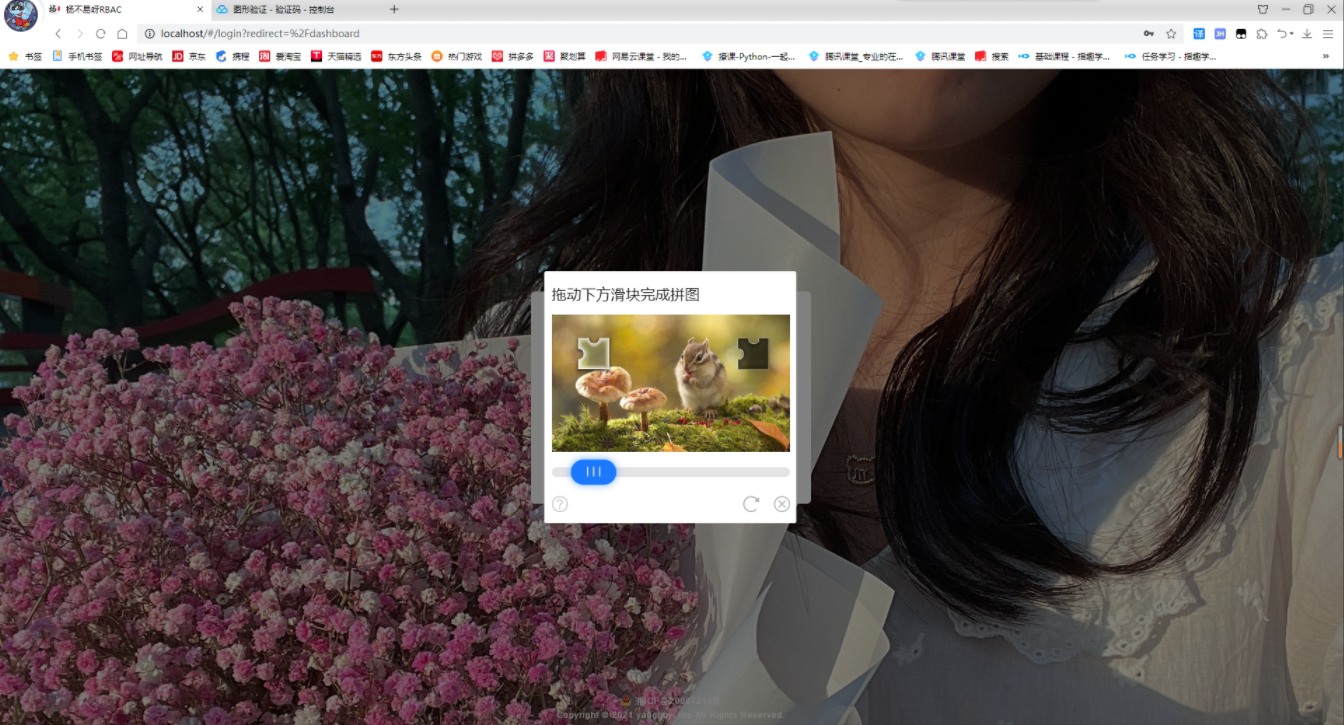
Step 1: enter Tencent cloud official website
https://console.cloud.tencent.com/captcha/graphical

1. Clicking the graphic verification code may need to be opened. Clicking to receive the free package will give you the number of times to use the verification code, which can be viewed in the package management.

2. Click Add verification
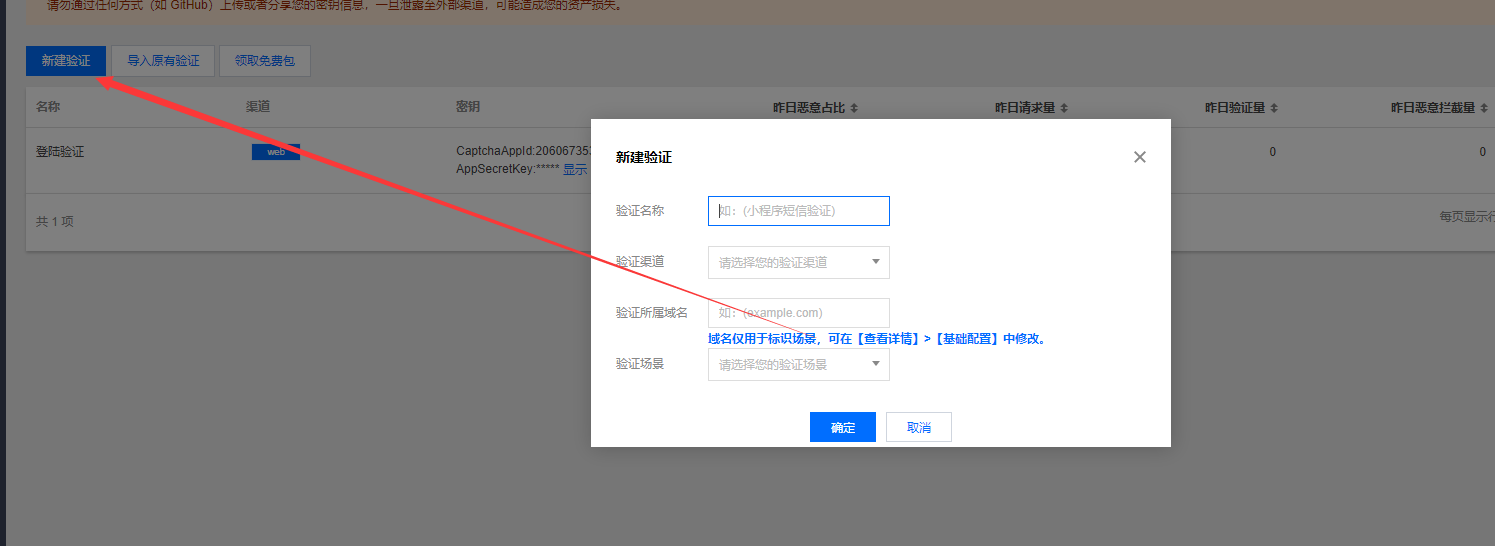
3. Fill in information
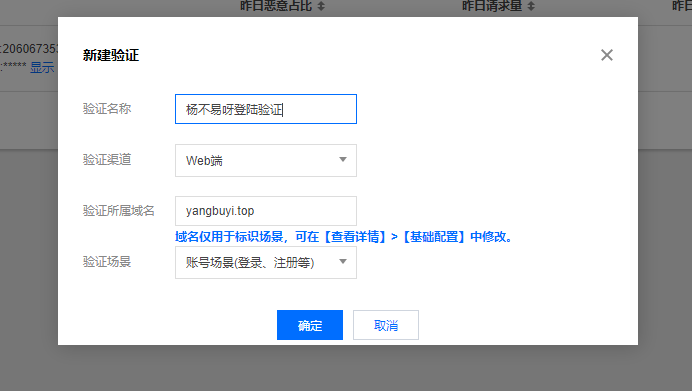
3.0 after new creation, you can view the verification code CaptchaAppId and AppSecretKey in the verification list
3.1 access to official documents
https://cloud.tencent.com/document/product/1110/36839
3.2 we will see a fast access. The first step is to obtain our own Tencent cloud key
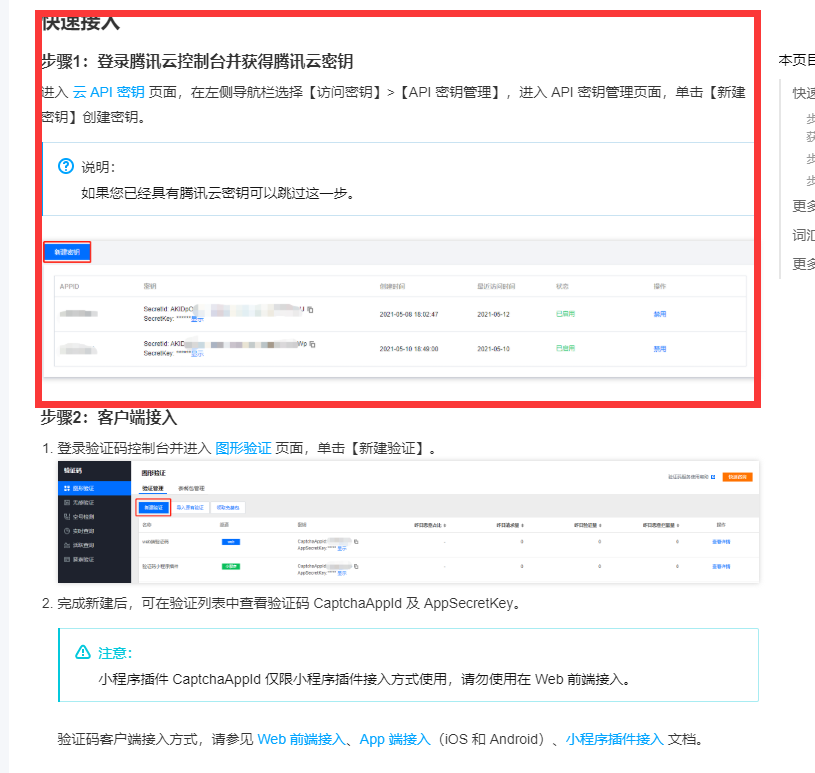
3.3 copy the key yourself first
APPID: xxxxxxxxxxxxxxxxxxx
SecretId: xxxxxxxxxxxxxxxxxxxxxxxxxxxx
SecretKey: xxxxxxxxxxxxxxxxxxxxxxxxxxxxxxxxxxxxxxxxxx
Step 2: create a front-end page
<!DOCTYPE html>
<html lang="en">
<head>
<meta charset="UTF-8">
<meta http-equiv="X-UA-Compatible" content="IE=edge">
<meta name="viewport" content="width=device-width, initial-scale=1.0">
<title>Yang is not easy-Web Front end access example</title>
<!-- Verification code program dependency(must) -->
<script src="https://ssl.captcha.qq.com/TCaptcha.js"></script>
</head>
<body>
<!--Clicking this element will automatically activate the verification code, This example uses button element, You can also use div,span etc.-->
<!--id : (Immutable) Elemental ID, Value must be 'TencentCaptcha'-->
<!--data-appid : (must) Verification Code CaptchaAppId, Get the verification code from Tencent cloud's verification code console, [graphic verification] on the verification code console page>[Verification list. If no verification is created, please select the appropriate verification channel and verification scenario according to the business needs-->
<!--data-cbfn : (must) Callback function name, The function name should be the same as data-cbfn identical-->
<!--data-biz-state :(Optional) Business custom transparent parameters, It will be obtained in the callback function( res.bizState)-->
<button id="TencentCaptcha" data-appid="Your verification code CaptchaAppId" data-cbfn="callbackName" data-biz-state="data-biz-state"
type="button">verification</button>
</body>
<script>
// The callback function needs to be placed under the global object window
window.callbackName = function (res) {
// Return results
// RET int validation result, 0: validation succeeded. 2: The user actively turns off the verification code.
// Ticket string the ticket that has been verified successfully. If and only if ret = 0, the ticket has a value.
// Captchaappid string verification code application ID.
// Bizstate any custom transparent parameters.
// Randstr string the random string of this verification, which needs to be brought when requesting the background interface.
console.log('callback:', res);
// res (user actively closes verification code) = {ret: 2, ticket: null}
// res (successful verification) = {ret: 0, ticket: "String", randstr: "String"}
if (res.ret === 0) {
// Copy results to clipboard
let str = `[randstr]->[${res.randstr}] [ticket]->[${res.ticket}]`;
let ipt = document.createElement('input');
ipt.value = str;
document.body.appendChild(ipt);
ipt.select();
document.execCommand("Copy");
document.body.removeChild(ipt);
alert('1. Return results( randstr,ticket)Copied to the clipboard, ctrl+v see.\n2. Open the browser console to view the complete returned results.');
}
}
</script>
</html>1. Write the verification code CaptchaAppId and get it from the verification code console of Tencent cloud. View the verification code in [graphic verification] > [verification list] on the verification code console page
<button id="TencentCaptcha" data-appid="2071484082" data-cbfn="callbackName" data-biz-state="data-biz-state" type="button">verification</button>
2. Open the page to view the effect
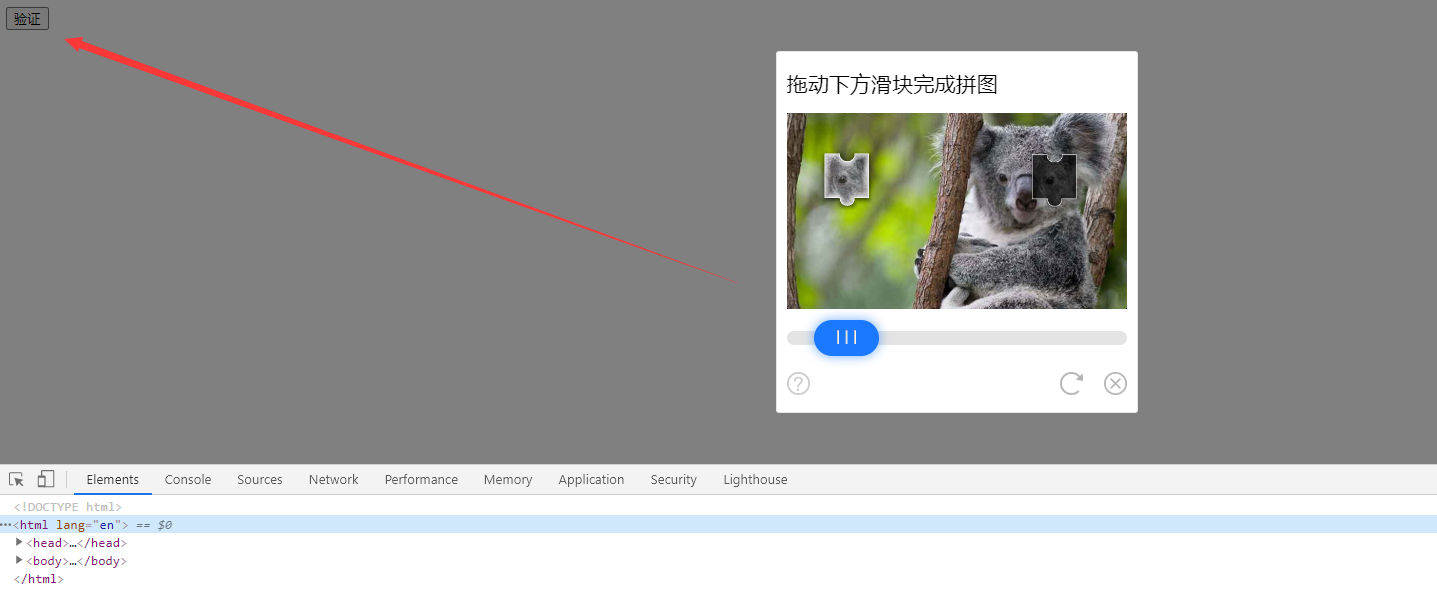
3. Slide the slider to the end point for calibration
// Return results // RET int validation result, 0: validation succeeded. 2: The user actively turns off the verification code. // Ticket string the ticket that has been verified successfully. If and only if ret = 0, the ticket has a value. // Captchaappid string verification code application ID. // Bizstate any custom transparent parameters. // Randstr string the random string of this verification, which needs to be brought when requesting the background interface. [randstr]>[@uKe] [ticket]>[t03vNwGSyE5PYZpSALqZsjsr7M5Z8lzRMhzgC7UExz7_DSmmxq_B1iLBB_VYhxp76wY5jQXVOdq_K2Ye8jjx7XiDSRmDAT3sJAME9NUlgxqQoyVOyDpdOUjbA**]
4. Then Tencent verification code access has been completed. Next, we will verify the connection with the back end
Step 3: create describecaptcharesult Maven backend project
1. Add dependency
<dependencies>
<dependency>
<groupId>com.tencentcloudapi</groupId>
<artifactId>tencentcloud-sdk-java</artifactId>
<!-- go to https://search.maven.org/search?q=tencentcloud-sdk-java and get the latest version. -->
<!-- succeed in inviting sb. https://search. maven. org/search? Q = tencentcloud SDK Java query all versions. The latest version is as follows -- >
<version>3.1.217</version>
</dependency>
</dependencies>
<repositories>
<repository>
<id>nexus-tencentyun</id>
<name>Nexus tencentyun</name>
<url>https://mirrors.tencent.com/nexus/repository/maven-public/</url>
</repository>
</repositories>2. Create the tool class DescribeCaptchaResultUtils
public class TencentCaptchaUtils {
/**
* Verification of Tencent verification code
* @param randStr The random string returned by the front-end callback function
* @param token(Ticket) User authentication ticket returned by the front-end callback function
* @return
*/
public static boolean tencentCaptcha(String randStr, String token) {
try {
/*
Action yes String Public parameter, value of this interface: DescribeCaptchaResult.
Version yes String Public parameter, value of this interface: July 22, 2019.
Region no String Public parameter. This interface does not need to pass this parameter.
CaptchaType yes Integer Fixed filling value: 9. Different verification code types can be configured on the console.
Ticket yes String User authentication ticket returned by the front-end callback function
UserIp yes String The IP of the verification code user obtained from the transparent service side
Randstr yes String The random string returned by the front-end callback function
CaptchaAppId yes Integer Verification code application ID
AppSecretKey yes String The verification key used to verify the verification code ticket on the server side should be kept confidential and should not be disclosed to a third party
BusinessId no Integer Business ID, a website or application uses this service in multiple businesses, and statistics are distinguished by this ID
SceneId no Integer Scenario ID: there are multiple scenarios using this service under the business of the website or application. Statistics are distinguished by this ID
MacAddress no String mac address or unique device ID
Imei no String Mobile device number
NeedGetCaptchaTime no Integer Whether to return the time when the front end obtains the verification code. Value 1: it needs to be returned
* */
Credential cred = new Credential("Your Tencent cloud key", "Your Tencent cloud key");
HttpProfile httpProfile = new HttpProfile();
httpProfile.setEndpoint("captcha.tencentcloudapi.com");
ClientProfile clientProfile = new ClientProfile();
clientProfile.setHttpProfile(httpProfile);
CaptchaClient client = new CaptchaClient(cred, "", clientProfile);
DescribeCaptchaResultRequest req = new DescribeCaptchaResultRequest();
// Fixed filling value: 9. Different verification code types can be configured on the console
req.setCaptchaType(9L);
// User authentication ticket returned by the front-end callback function
req.setTicket(token);
// Please obtain the ip address of the requester through the service by transmitting the ip of the verification code user obtained by the service side
req.setUserIp("127.0.0.1");
// The random string returned by the front-end callback function
req.setRandstr(randStr);
// Verification code application ID
req.setCaptchaAppId(You added verified CaptchaAppId);
// The verification key used to verify the verification code ticket on the server side should be kept confidential and should not be disclosed to a third party
req.setAppSecretKey("You added a new authentication key AppSecretKey");
// Whether to return the time when the front end obtains the verification code. Value 1: it needs to be returned
req.setNeedGetCaptchaTime(1L);
// Scenario ID: there are multiple scenarios using this service under the business of the website or application. Statistics are distinguished by this ID
req.setSceneId(1L);
DescribeCaptchaResultResponse resp = client.DescribeCaptchaResult(req);
Gson gson = new Gson().newBuilder().create();
Map map = gson.fromJson(DescribeCaptchaResultResponse.toJsonString(resp), Map.class);
System.out.println(map);
if ("ok".equalsIgnoreCase(map.get("CaptchaMsg").toString())){
// success
return true;
} else {
return false;
}
} catch (TencentCloudSDKException e) {
System.out.println(e.toString());
return false;
}
}
/**
verification
*/
public static void main(String[] args) {
boolean b = tencentCaptcha("@UP0", "t03cnXnT-SNq8jywYVz4h22VFkNbQxXiShmEomvQRUAXaF9UWJBkLWDyCqZcONCjlYAC3-ytSkQ2IJtrG7xNJwfvvyD-QxgnNL0iSSkXyXGd3ePHFfLI_8FfA**", null);
System.out.println(b);
}
}3. Start synchronous verification with the front end

4. Verification succeeded ok
Use VUE to access Tencent slider
1. Copy the slider js to the global html page

2. Write display slider method
tencentCaptcha() {
const captchaId = 'Yours appid' // Tencent slider verification code appid
// Generate a slider verification code object
const _this = this// Processing here is because calling the slider verification code verification method fails
// eslint-disable-next-line no-undef
var captcha = new TencentCaptcha(captchaId,
function(res) {
// Background verification method
_this.handleLoginMe(res)// Verification of graphic verification code
})
// Slider display
captcha.show()
}3. Call the backend interface tool class verification method to pass two parameters
handleLoginMe(res) {
// Back end verification parameters ()
this.loginForm.params.randStr = res.randstr
this.loginForm.params.token = res.ticket
// Start login request
this.$store.dispatch('user/login', this.loginForm).then(() => {
// Your business logic
}).catch(() => {
})
}